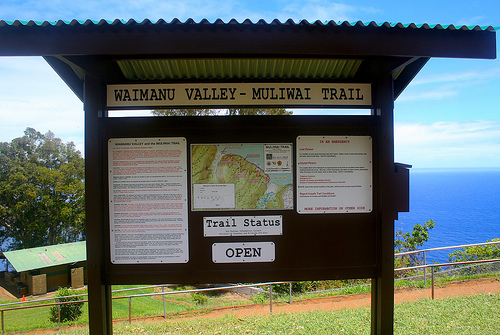The Muliwai Trail can be very dangerous, especially in bad weather. There are many hazards that you need to be aware of to keep you and your companions safe. We recommend using the buddy system. Having a buddy with you who can help you in case of emergency can help save your life.
There have been numerous injuries on the trail. Knowing the following hazards ahead of time can help you be safe and have a great trip. There are four emergency helipads along the trail used for maintenance, fire and rescue teams only. Keep them clear and never camp on them.
Safety Concerns
NO EMERGENCY SERVICES– In case of emergency, someone must hike out for help or signal a passing helicopter or boat. There is no cellular phone coverage in or around the area.
TRAIL– In places the trail is narrow with steep drop-offs, uneven because of protruding roots and rocks, or slippery because of mud or loose rocks. Wear appropriate footwear.
CROSSING STREAMS– Never cross a flooded stream. Hawaii’s gently flowing, clear streams can quickly become deep muddy torrents. Avoid crossing swift flows when the water level is above your knees. Wait – the water level may recede as quickly as it rose.
POTENTIALLY FATAL. Use extreme caution when hiking in wet weather; footing can be slippery and rocks may be dislodged from slopes above the trail. High winds often cause tree and branch fall on the trail and in the campsites. High surf occasionally floods the camp grounds. Check local weather forecasts before departing on your trip.
OCEAN SWIMMING– Swimming, wading, and bodysurfing are not recommended unless you are an experienced swimmer familiar with local conditions. Surf and currents are variable and can be treacherous even during summer. There are no lifeguards.
MOUNTAIN CLIMBING– Hawaii’s volcanic mountains are too crumbly for roping or climbing and plants are easily uprooted.
TSUNAMIS (tidal waves)- Tsunamis are an infrequent, but great hazard on low-lying coastal areas around the beaches. A few hours warning may be given, unless the waves are locally generated. Evacuate immediately to high ground and do not return until given official clearance. Tsunamis are often preceded by an unusual drop in sea level prior to the first waves.
HAZARDS: WEATHER. This region of the Big Island receives over 100 inches of rain annually. Heavy rains regularly cause flash floods which can make attempted stream crossings.
Health Concerns
STREAM WATER– Boil, filter or treat all drinking water. While swimming in streams, or drinking untreated stream water, it is possible to contract leptospirosis. This potentially fatal disease invades the body through cuts and other openings and is often mistaken for hepatitis.
SUNBURN/HEAT EXHAUSTION– Beware of the midday tropical sun. Avoid strenuous exercise during hot periods, drink plenty of water, and use sunscreen to protect against ultraviolet radiation, even when the sky is overcast.
HARMFUL PLANTS AND ANIMALS– Never taste or eat unfamiliar plants or use them for food skewers. Keep your area clean to avoid attracting pests. Spiders, scorpions, centipedes and other harmful insects like hidden areas such as under leaf litter and rocks. Hawaii has no snakes or large carnivorous mammals.
